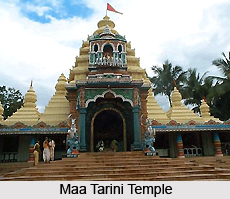 One legend with a delightful association with the rathyatra concerns King Purusottam Dev (15th century). Traveling around South India, the young king chanced to see Princess Padmavati of Kanchi, and was charmed by her beauty. He sent his envoy to her father proposing marriage. The proposal was welcomed. The minister of Kanchi proceeded to Puri to finalize the arrangements for the wedding. That was the time of the car festival. It began with the king sweeping a part of the chariot where the deity was to be placed. This signified that even the king was a humble servant of the Lord. (The custom continues to this day, the scion of the Raj family of Puri performing the rite.)
One legend with a delightful association with the rathyatra concerns King Purusottam Dev (15th century). Traveling around South India, the young king chanced to see Princess Padmavati of Kanchi, and was charmed by her beauty. He sent his envoy to her father proposing marriage. The proposal was welcomed. The minister of Kanchi proceeded to Puri to finalize the arrangements for the wedding. That was the time of the car festival. It began with the king sweeping a part of the chariot where the deity was to be placed. This signified that even the king was a humble servant of the Lord. (The custom continues to this day, the scion of the Raj family of Puri performing the rite.)
When King Trilochona Bhanja (King of Khedhujhar) died, Govinda Bhanja had to return to his kingdom. King Purusottam Dev wanted to give Govinda Bhanja something as he had helped him to avenge his insult and Princess Padvati to his kingdom. Govinda Bhanja wanted only one thing for himself .He wanted to bring Maa to his kingdom. King Purusottam Dev agreed to this and asked him to ask Maa`s permission. Govinda Bhanja prayed and the Goddess agreed with one condition that she will go with him as long as Govinda Bhanja doesn`t look back to see her. With this Condition, she went with Govinda Bhanjha to Kendujhar(kheojhar). From Puri to Khedujhar Maa horse hoof sounds were audible. On the outskirts of Khedujhar lies river Baitarini. On the forest of Kheojhar, Maa`s horse hoofs were not audible to Govinda Bhanja. Frightened that Maa stayed behind, he turned and instantaneously Maa turned into stone. Govinda Bhanjha prayed Maa for forgiveness in vain. She stayed in the wild forest and asked Govinda Bhanjha to worship in that place. Till today Maa Tarini is being worshipped in Ghatagaon, Kheojhar.
Festivals:
Diverse festivals are observed at the holy shrine of Maa Tarini.
•Makara Sankranti (January14-16 every year)
•Maha Visubha Sankranti (April 14-16 every year)
•Raja Sankranti (June14-16 every year)
Apart from these festivals several other festivals are also observed like Dassera and Diwali.





















